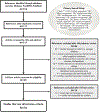Social Cognitive Interventions for Adolescents with Autism Spectrum Disorders: A Systematic Review
- PMID: 32469804
- PMCID: PMC7430499
- DOI: 10.1016/j.jad.2020.05.134
Social Cognitive Interventions for Adolescents with Autism Spectrum Disorders: A Systematic Review
Abstract
Introduction: Autism spectrum disorder (ASD), a heterogeneous neurodevelopmental disorder, impacts social experience and functioning throughout the lifespan. Although the postnatal phase of neuroplasticity has been a focus for early interventions in ASD, a second critical period in adolescence has emerged as a promising target for experience-dependent remediation. Interventions addressing the multidimensional construct of social cognition have also shown potential as a therapeutic approach. Yet, to date, evidence-based social cognitive interventions (SCIs) designed for adolescents with ASD are still lacking. In this review, we aim to survey and synthesize the extant literature on SCIs for adolescents with ASD in order to inform next steps for treatment research.
Methods: Using the PRISMA guidelines, we limited our queries to peer-reviewed, English-language journal articles describing SCI trials for adolescents with ASD using a randomized controlled design.
Results: Eighteen articles in total met our inclusion/exclusion criteria. We present and discuss these trials using the non-exclusive categories of group-based social skills interventions, experiential-based interventions, and computer-assisted interventions.
Limitations: To ensure a focus on adolescence, we excluded trials with teen-age participants if mean subject age was not between 12-18 years. Also, given the variability across studies in outcome measures, study designs, samples, and effect sizes, findings were incommensurable.
Conclusions: Several reviewed SCIs reported post-treatment improvements in varied domains but findings were inconsistent. Further investigations of existing and novel interventions are warranted; attention to assessing and improving long-term skill transfer is essential. Technology-assisted augmentations may improve treatment efficacy and ecological validity of therapeutic gains.
Copyright © 2020 Elsevier B.V. All rights reserved.
Conflict of interest statement
Declaration Of Competing Intrest None
References
-
- American Psychiatric Association, A. (2013). Diagnostic and Statistical Manual of Mental Disorders.
-
- Blakemore SJ (2008). The social brain in adolescence. Nat Rev Neurosci, 9(4), 267–277. - PubMed
-
- Choque-Olsson N, Flygare O, Coco C, Görling A, Råde A, Chen Q, … Bölte S (2017). Social Skills Training for Children and Adolescents With Autism Spectrum Disorder: A Randomized Controlled Trial. Journal of the American Academy of Child & Adolescent Psychiatry, 56(7), 585–592. - PubMed
-
- Cohen Kadosh K, Linden DE, & Lau JY (2013). Plasticity during childhood and adolescence: innovative approaches to investigating neurocognitive development. Dev Sci, 16(4), 574–583. - PubMed
Publication types
MeSH terms
Grants and funding
LinkOut - more resources
Full Text Sources
Medical
Miscellaneous


